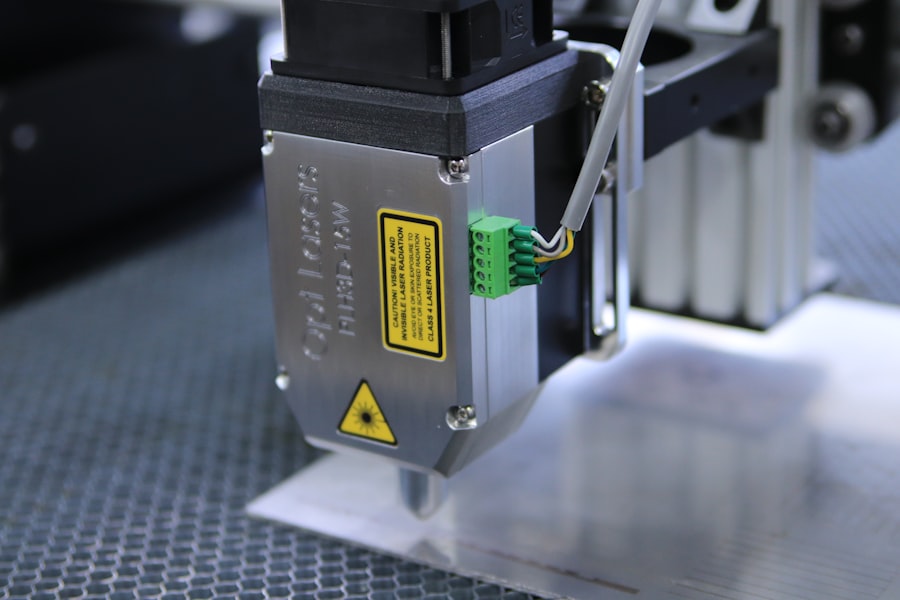Laser hair removal is a popular cosmetic procedure that utilizes concentrated beams of light to target and eliminate unwanted hair. The technology behind this method is based on the principle of selective photothermolysis, where the laser light is absorbed by the pigment in the hair follicles. This absorption generates heat, which effectively damages the follicles and inhibits future hair growth.
As you consider this option, it’s essential to understand how the process works and what it entails. The procedure is typically performed in a clinical setting by trained professionals. During your session, you will wear protective eyewear to shield your eyes from the laser light.
The practitioner will then apply a cooling gel or device to your skin to minimize discomfort. As the laser is activated, you may feel a slight stinging sensation, often compared to the snap of a rubber band against your skin. The duration of each session can vary depending on the size of the area being treated, but many find the process relatively quick and manageable.
Key Takeaways
- Laser hair removal uses concentrated light to target and destroy hair follicles, leading to permanent hair reduction.
- Factors affecting the number of laser sessions include hair color, skin color, hair thickness, and the area being treated.
- Consultation and assessment with a qualified provider are essential to determine the right treatment plan for each individual.
- The typical number of laser sessions required for optimal results is usually between 6-8, spaced 4-6 weeks apart.
- Follow-up sessions are important to target any remaining hair and ensure long-term results.
Factors Affecting Number of Laser Sessions
Hair Type and Color
Darker hair tends to respond better to laser treatment because the contrast between the hair and skin allows for more effective targeting by the laser. On the other hand, if you have lighter hair or very fine hair, you may require additional sessions to achieve optimal results.
Skin Type
Individuals with lighter skin tones generally see quicker results because the laser can more easily differentiate between the pigment in the hair and the surrounding skin. Conversely, those with darker skin may need more sessions due to the increased risk of skin damage or discoloration.
Hormonal Influences
Hormonal influences can affect hair growth patterns, meaning that individuals with hormonal imbalances may find that they require more treatments than others.
Consultation and Assessment

Before embarking on your laser hair removal journey, a thorough consultation and assessment are crucial. During this initial meeting, you will discuss your hair removal goals and any concerns you may have with a qualified practitioner. They will evaluate your skin type, hair color, and medical history to determine if you are a suitable candidate for the procedure.
This step is vital as it helps tailor the treatment plan to your specific needs. Your practitioner will also explain what to expect during the sessions, including pre-treatment care and post-treatment guidelines. They may recommend avoiding sun exposure or certain medications that could increase sensitivity before your sessions.
This consultation is an excellent opportunity for you to ask questions and clarify any doubts, ensuring that you feel comfortable and informed about the process ahead.
Typical Number of Laser Sessions
| Area of Treatment | Typical Number of Laser Sessions |
|---|---|
| Upper Lip | 4-6 sessions |
| Underarms | 6-8 sessions |
| Bikini Area | 6-8 sessions |
| Legs | 8-10 sessions |
On average, most individuals require between six to eight sessions for optimal results, but this can vary widely based on individual circumstances. Each session is typically spaced four to six weeks apart, allowing time for hair growth cycles to complete. It’s important to understand that hair grows in different phases, and laser treatment is most effective during the anagen phase when the hair is actively growing.
As you progress through your sessions, you may notice a significant reduction in hair density and thickness. Some areas may respond more quickly than others; for instance, facial hair often requires fewer sessions compared to larger areas like legs or backs. Your practitioner will monitor your progress and adjust your treatment plan as necessary, ensuring that you achieve the best possible outcome.
Importance of Follow-Up Sessions
Follow-up sessions play a crucial role in maintaining the results of your laser hair removal treatment. After completing your initial series of sessions, you may still experience some regrowth over time due to various factors such as hormonal changes or new hair follicles entering the growth phase. Regular follow-up treatments can help manage this regrowth effectively.
Typically, follow-up sessions are scheduled every six months to a year after your initial treatments. These maintenance sessions are generally shorter and less frequent than the initial series, but they are essential for keeping unwanted hair at bay. By committing to these follow-ups, you can ensure that your skin remains smooth and free from unwanted hair for an extended period.
Managing Expectations

Understanding Variable Results
When considering laser hair removal, it’s crucial to manage your expectations. While many individuals experience significant reductions in hair growth, results can vary from person to person. Some may achieve near-complete hair removal, while others may still see some regrowth that requires ongoing maintenance.
A Commitment to the Process
It’s essential to recognize that laser hair removal is not a one-time solution; it requires commitment and patience. You may not see immediate results after your first session, as multiple treatments are necessary for optimal outcomes.
Setting Realistic Expectations for Success
By setting realistic expectations and understanding the process, you can approach your treatment with a positive mindset and greater satisfaction. This mindset is key to achieving the best possible results from your laser hair removal treatment.
Possible Side Effects and Risks
While laser hair removal is generally considered safe, it’s essential to be aware of potential side effects and risks associated with the procedure. Common side effects include temporary redness, swelling, or discomfort in the treated area, similar to what you might experience after a mild sunburn. These effects typically subside within a few hours to a couple of days.
In rare cases, more severe side effects can occur, such as blistering or changes in skin pigmentation. Individuals with darker skin tones may be at a higher risk for these complications due to increased melanin levels in their skin.
Choosing the Right Provider
Selecting the right provider for your laser hair removal treatment is one of the most critical steps in ensuring a successful experience. Look for practitioners who are licensed and experienced in performing laser treatments. It’s beneficial to read reviews or seek recommendations from friends or family who have undergone similar procedures.
During your consultation, pay attention to how comfortable you feel with the provider and their level of professionalism. A good practitioner will take the time to answer your questions thoroughly and provide clear explanations about the process and expected outcomes. By choosing a reputable provider, you can enhance your chances of achieving satisfactory results while minimizing potential risks associated with the procedure.
In conclusion, laser hair removal offers an effective solution for those seeking long-term hair reduction. By understanding how it works, what factors influence treatment outcomes, and how to manage expectations throughout the process, you can make informed decisions about your hair removal journey. With proper consultation and care from a qualified provider, you can enjoy smoother skin and greater confidence in your appearance for years to come.
If you are curious about how many laser sessions it takes to remove hair forever, you may want to check out this article on inlaserhairremoval.com. This article provides valuable information on the process of laser hair removal and what to expect in terms of the number of sessions needed for permanent hair reduction. It can help you make an informed decision about whether laser hair removal is the right choice for you.
FAQs
How many laser sessions does it take to remove hair forever?
It typically takes 6-8 laser hair removal sessions to achieve permanent hair reduction.
How often should laser hair removal sessions be scheduled?
Laser hair removal sessions are usually scheduled 4-6 weeks apart to target hair in different stages of growth.
What factors can affect the number of laser sessions needed?
Factors such as hair color, hair thickness, skin color, and hormonal imbalances can affect the number of laser sessions needed for permanent hair reduction.
Is laser hair removal permanent?
Laser hair removal can achieve permanent hair reduction, but some individuals may require occasional maintenance sessions to target any regrowth.
Are there any risks or side effects associated with laser hair removal?
Common side effects of laser hair removal include redness, swelling, and temporary pigment changes. It is important to seek treatment from a qualified and experienced professional to minimize risks.




